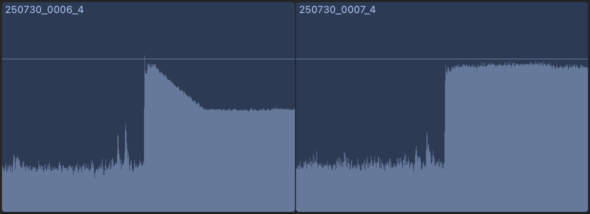Contents
I recently replaced a horrible, dodgy Zoom H4n with a Tascam Portacapture X8, for recording (primarily) theatre and music performances. One of the appeals was 32-bit floating-point recording which was literally promised to eliminate concerns about input levelling, clipping, and noise:
The reality is, with 32-bit float recording you can turn on your recorder, hit record, and be 100% confident that you’ll be capturing high-fidelity, low-noise audio, without ever adjusting your input level.
Why 32-bit Float Recording, Tascam
…the huge dynamic range that 32-bit float offers means your audio is always captured well above the noise floor, and also makes it basically impossible to distort due to high input levels.
Why 32-bit Float Recording, Tascam
Five minutes of some trivial testing shows that this is just not true.
Noise is still affected by input gain
Here’s a composed recording of four 3-second clips recording the room tone in my office. They are (in order): Auto gain, 57dB, 35dB, 0dB:
As you can hear, auto and maximum input gain in this case have very similar noise levels (which is to say, perceptually none), but as you reduce the recorder’s input gain (and instead apply the gain in post) the noise increases substantially and becomes very noticeable.
Granted this is a very big gain application – 57dB – which you would hopefully never need to apply to a real recording, but nonetheless it demonstrates that Tascam’s claims are exaggerations at best; if you actually had the Portacapture X8’s input gain set to 0dB and recorded quiet sounds, you would in fact have problems with noise – problems that would be avoided with a correct input gain setting.
Clipping still happens if input gain is too high
The recorder clearly applies actual analog amplification and can still saturate its ADCs, as shown in this composite of three gain levels. They are (in order): Auto gain, 35dB, 57dB.
Warning: annoying, distorted sound.

It only went over by about 3dB (at 57dB input gain), but that was enough to destroy the input signal and make the recording unusable.
Auto Gain still affects the recording
In the above tests I included the Auto Gain setting, even though it doesn’t exhibit particularly high noise nor does it clip in these simple sound environments (basically constant sound levels). And it worked pretty well (not optimal input gain levels, but close enough for my taste).
But, I was curious if it had any effect at all – again, reading about 32-bit floating-point recording online, you’d be forgiven for thinking Auto Gain has no impact on the actual recorded data. Many people liken the format to camera raw files, and some explicitly state that Auto Gain has no impact on the bits that get written to disk.
This is completely false, at least in the case of this Tascam Portacapture X8. It’s trivial to see why:

Auto Gain still does exactly what it always does – it changes the gain in response to the input. That change is baked into the recorded audio track(s).
So in a nutshell, 32-bit floating-point recording might provide slightly more flexibility in some situations, but it does not mean you can ignore your input level settings, it does not mean you can use Auto Gain in every scenario, and it does not mean you cannot clip.
Addendum: Technical details
I tested post-production gain changes in Final Cut Pro, Logic Pro, & Audacity. All produced the exact same results (to my ears). I had read that Final Cut Pro sometimes ‘bakes in’ clipping with 32-bit float inputs, as if it’s pre-rendering them down to some smaller dynamic range, so I wanted to rule out some Final Cut Pro-specific stupidity. It’s possible that all these editors are doing that, but I’d be flabbergasted if that’s true.
The “industrial noise” sample I used was my dehumidifier, which is about 66dB according to DecibelX on my iPhone 14 Pro. My office room tone is about 42dB according to the same app.
I used Sennheiser K6 modules with an ME65 and ME66 attached, plugged into the Tascam Portacapture X8 via 3′ Cable Matters XLR cables.
I recorded at 96kHz because that’s what I’ll use most often. I like the aliasing headroom above 48kHz (even though of course my final outputs are almost always 44.1kHz or 48kHz), but don’t see evidence that 192kHz provides meaningful additional benefit (and it also hurts the frequency response significantly, compared with 48kHz and 96kHz, according to Tascam).

